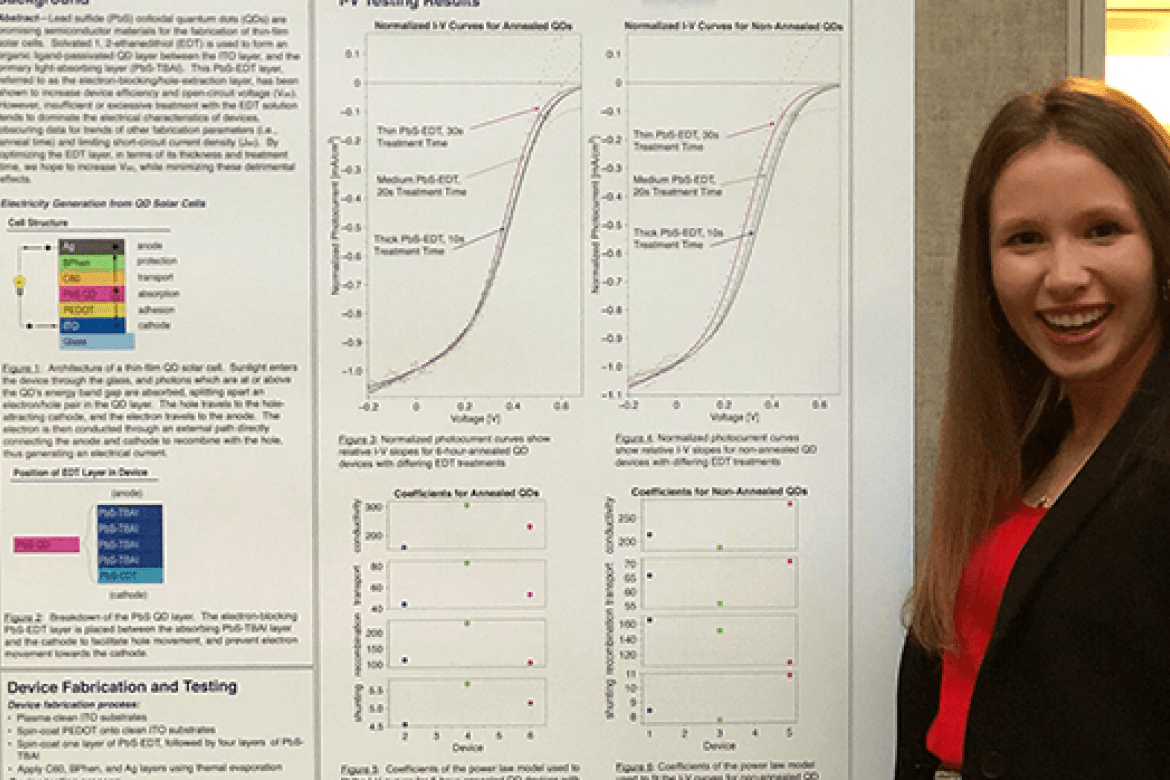My first experience in science research

This internship was my first experience in science research, and it made me want to continue on to a future in research related to renewable energy.
Internship: The Arango Lab at Mount Holyoke researches novel semiconductor materials for use in making thin-film solar cells. These types of solar cells are made by depositing layers of materials, on the scale of nanometers, on to thin substrates. These types of solar cells would be less bulky, and have much lower production and installation costs than traditional silicon solar panels. The lab is currently focused on investigating the potential for using lead sulfide (PbS) quantum dots as the primary light-absorbing layer in thin-film cells. Quantum dots are a promising semiconductor material for solar cells because of their tunable energy band gaps, which can be adjusted to absorb different sections of the broad solar spectrum.The lab is one of several in which MHC physics students can gain high-quality, hands-on research experience.
Duties and tasks: My internship was centered around the fabrication, testing, and analysis of solar cells. The fabrication process consisted of two parts: spin-coating substrates with layers of solvated PbS quantum dots, and using thermal evaporation to deposit organic layers and a silver anode. I tested the devices’ optical properties using spectrophotometry, which measures how much light is transmitted and reflected through the layers of the cell. I also tested the devices’ electrical characteristics, which includes the most important indicators of their performance, including efficiency, open-circuit voltage, and short-circuit current density. These tests yielded data that I plotted using Datagraph software, which allowed us to make modifications to various parts of our fabrication process, working towards the ultimate goal of creating more efficient solar cells.
Maintaining a highly-detailed lab notebook was also an essential part of my time working in the lab. This included documenting every part of what I was doing during experiments, taking notes on the physics theory that we discussed as a group, and detailing the procedures for the equipment and software that I was learning how to use.
Best Advice: I would advise someone going into any internship, but especially a highly technical one, to do a lot of reading beforehand about the work that they’ll be doing. It really helps to have an understanding of the theory motivating lab work, both for your personal edification and for your ability to contribute meaningfully to the lab group when planning next steps in experiments.
Moving Forward: This internship was my first experience in science research, and it definitely made me want to continue on to a future in research related to renewable energy. I am continuing to work in the Arango Lab with 4 credits of an independent study this semester, where I am working on a project which is centered around optimizing the layer of one of the organic solutions that we spin-coat on to create solar cells. I enjoy the lab work itself, as well as being a part of the mission of the lab as it relates to renewable energy, which is an incredibly important sector to be developing in the face of the climate crisis.